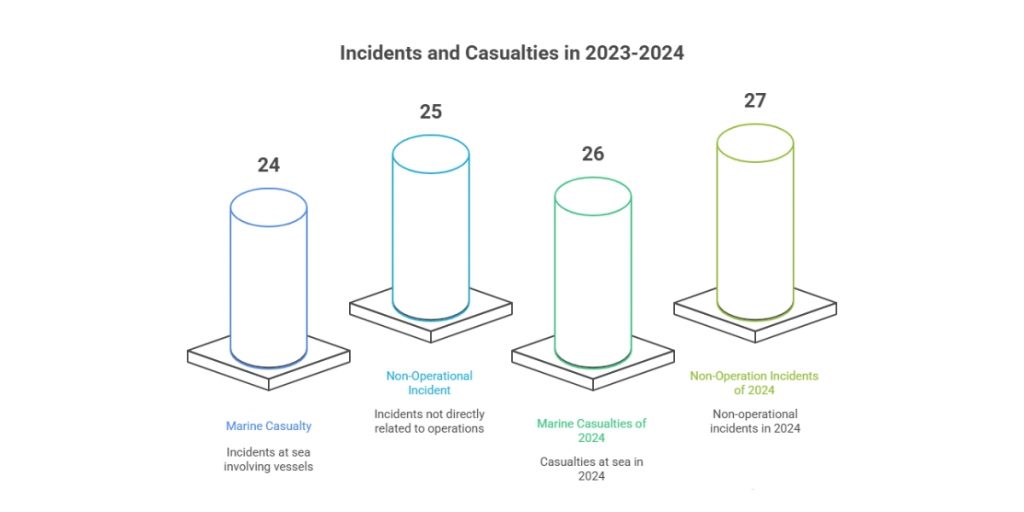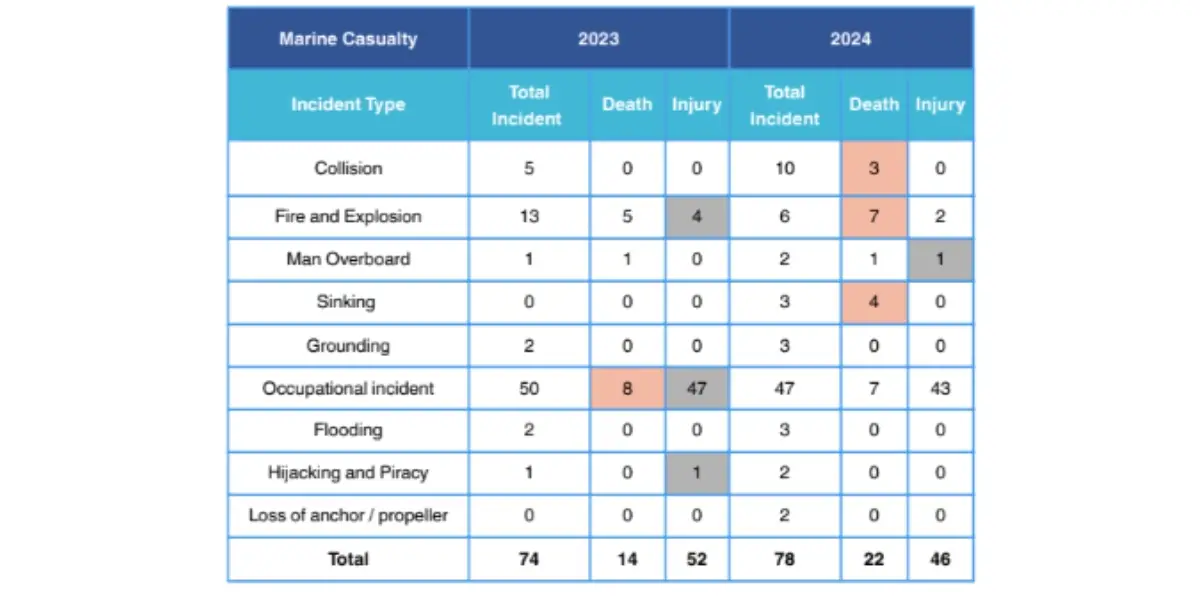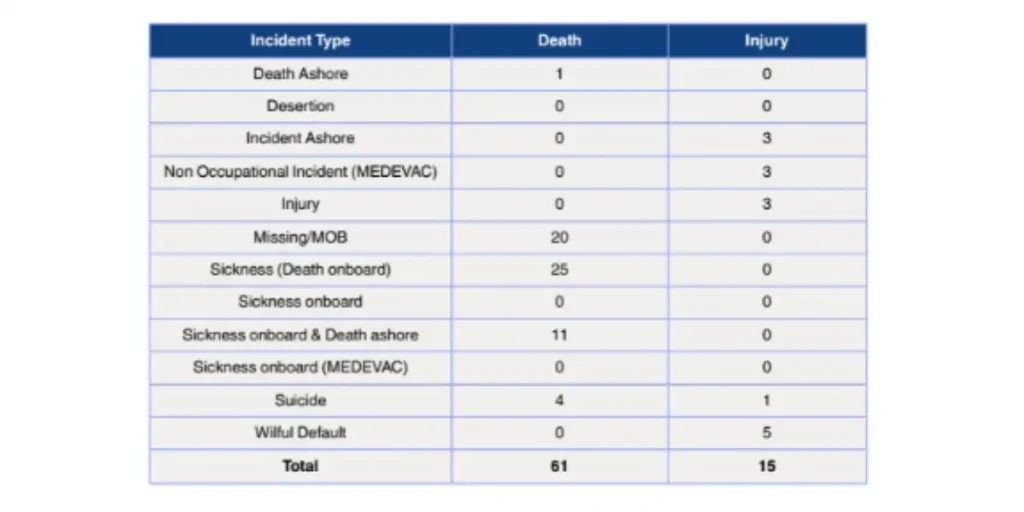India’s maritime sector is pivotal to the global shipping economy, with over 1.6 million seafarers involved in international trade and transport. In 2024, the Directorate General of Shipping (DGS) released a detailed Marine Safety Investigation Report, shedding light on the incidents affecting Indian-flagged vessels, Indian seafarers, and foreign-flagged ships operating within Indian waters. With 186 total reported incidents, the report represents an urgent call for reforms in risk management, crew safety, and incident response protocols.
As part of the proactive steps recommended, the report emphasizes the critical role of DG shipping-approved Doctors in conducting accurate medical assessments before deployment. Ensuring the physical and mental fitness of seafarers is a non-negotiable pillar in maintaining onboard safety and reducing non-operational casualties.

Furthermore, the report draws attention to the responsibilities of RPSL companies, which are licensed under the Recruitment and Placement Services License scheme. These companies are instrumental in not only supplying skilled manpower but also ensuring that their crew management practices are in line with international maritime labor standards and the directorate’s safety regulations.
The DGS report thus serves as both a data-driven analysis and a strategic guide for improving maritime safety outcomes through better training, stricter enforcement, and compliant RPSL companies.
Key Statistics and Incident Trends (2023 vs 2024)
Marine Casualties: A 5.4% Increase
- 2023: 74 incidents
- 2024: 78 incidents
- Deaths: Increased from 14 to 22
- Injuries: Decreased from 52 to 46

Non-Operational Incidents: A 36.7% Surge
- 2023: 79 incidents
- 2024: 108 incidents
- Deaths: Increased from 55 to 61
- Injuries: Increased from 2 to 15

This data represents a 21.6% escalation in total reported casualties between 2023 and 2024, reinforcing the urgency to implement improved safety protocols.
Breakdown of Major Marine Casualties in 2024
1. Occupational Incidents
- Most frequent category: 47 incidents
- Deaths: 7
- Injuries: 43
- Highlight: These are routine onboard injuries due to slips, falls, equipment failures, and confined space hazards. Most preventable, yet most frequent.
2. Fire & Explosion
- Incidents: 6
- Deaths: 7
- Injuries: 2
- Note: Fatality rate is the highest per incident. Rapid escalation often leaves little time for reaction.
3. Collision
- Incidents: 10
- Deaths: 3
- Insight: Collisions rose 100% from 2023, with the majority involving poor navigation or mechanical errors.
Analysis of Non-Operational Incidents
Top Categories:
- Sickness onboard leading to death: 25
- Missing/MOB (Man Overboard): 20
- Sickness Onboard & Death Ashore: 11
- Suicide: 4 (down from 5 in 2023)
Over 60% of non-operational incidents involved crew aged 20–40, emphasizing the need for better onboarding support, mental health access, and crew welfare checks.
Flag-wise & Vessel-wise Insights
Flags with Highest Incident Reports (Marine Casualties)
- Marshall Islands: 14
- Panama: 11
- Singapore: 11
- India: 16
Vessels Involved Most Frequently
- Bulk Carriers
- Container Ships
- Oil/Product Tankers
These vessel types are more prone to structural stress and high-risk cargo, especially under tight schedules and port congestion.
Human Impact: Deaths and Injuries
Marine Casualty Fatality Breakdown
- Fire & Explosion: 31.8%
- Occupational Incidents: 31.8%
- Sinking: 18.2%
- Collision: 13.6%
- Man Overboard: 4.5%
Non-Operational Incident Fatalities
- Sickness (onboard): 41%
- Missing/MOB: 32.8%
- Sickness onboard & Death ashore: 18%
This indicates that crew health and emergency response are now more urgent than even navigational issues in many cases.
Age & Rank-Based Vulnerability Insights
- Most affected age group: 30–40 years (48.7%)
- Least affected: 60+ (0%)
- Most impacted ranks: Fitters, ABs, Seamen, Cadets
These groups handle more physical labor and operational exposure, highlighting the need for tailored training and PPE enforcement.
Territorial Risk Distribution
- Incidents Beyond Indian EEZ: 82%
- Within Indian EEZ: 5%
- Indian Territorial Waters: 13%
This implies a critical need for international collaboration in safety protocols and faster long-range emergency deployment.
Case Studies to Watch
1. Sinking of MV ITT Puma
- Resulted in loss of life and oil spillage.
- Demonstrates how older vessels face compounded risks under stress.
2. Maersk Frankfurt Fire
- High-intensity fire in the engine room.
- Required international assistance and reinforced onboard fire safety guidelines.
3. MV Dali—Collision with Francis Scott Key Bridge
- International attention. Reflected structural impact and underscored bridge navigation protocols.
India’s Proactive Measures in 2024
- The DGComm Center now runs 24/7 with real-time incident coordination.
- Emergency Towing Vessels (ETVs) are strategically deployed on the East & West Coasts.
- The revamped exit exam system ensures higher training standards.
- Zero suicide and desertion cases were reported on Indian-flagged vessels, showing good management practices.
Recommendations for 2025 and Beyond
- Mandatory crew safety drills—especially for fire and fall prevention.
- Mental health training as part of pre-departure.
- Real-time fatigue monitoring systems are onboard.
- Proactive vessel audits for structural integrity.
- Monthly feedback loops from crew to shipping authorities.
Conclusion
The 2024 Marine Safety Investigation Report is not just a document—it’s a warning, a guide, and a roadmap. As India emerges as a global maritime power, the health, safety, and resilience of its seafarers must remain at the center of national strategy. From occupational injuries to piracy threats, every incident must be treated as a teachable moment for the entire ecosystem.
What is the 2024 Marine Safety Investigation Report?
The 2024 report by the Directorate General of Shipping (DGS) analyzes 186 marine incidents involving Indian and foreign-flagged vessels, highlighting safety gaps, crew health issues, and enforcement recommendations.
What is an RPSL company, and why is it important?
RPSL (Recruitment and Placement Services License) companies recruit and manage seafarers while ensuring compliance with maritime labor and safety regulations.
Which types of vessels were involved in most incidents in 2024?
Bulk carriers, container ships, and oil/product tankers were most frequently involved due to high-risk cargo handling and operational stress.
Which flags recorded the highest number of marine casualties?
Indian-flagged vessels led with 16 incidents, followed by Marshall Islands (14), Panama (11), and Singapore (11).
What age group and rank are most vulnerable to incidents?
Seafarers aged 30–40 and those holding ranks like ABs, cadets, and fitters faced the most incidents due to physical workloads and operational exposure.
What were the top causes of fatalities in 2024?
The leading causes included fire & explosion (31.8%), occupational accidents (31.8%), and sickness onboard (41% in non-operational categories).
How is India responding to rising maritime safety concerns?
India has launched 24/7 DGComm Centers, deployed Emergency Towing Vessels (ETVs), revamped exit exams, and introduced stricter training and audit systems.
What are the key recommendations for 2025 and beyond?
The report suggests mandatory fire/fall drills, mental health training, real-time fatigue monitoring, structural vessel audits, and monthly feedback systems from crew.
Why is there a rise in marine casualties and non-operational incidents?
Increased workloads, insufficient training, aging vessels, and lack of medical screening have contributed to a 21.6% rise in total reported casualties from 2023 to 2024.
What role do DG Shipping-approved doctors play in maritime safety?
These doctors ensure seafarers meet required physical and mental health standards before deployment, helping reduce onboard medical emergencies and fatalities.
